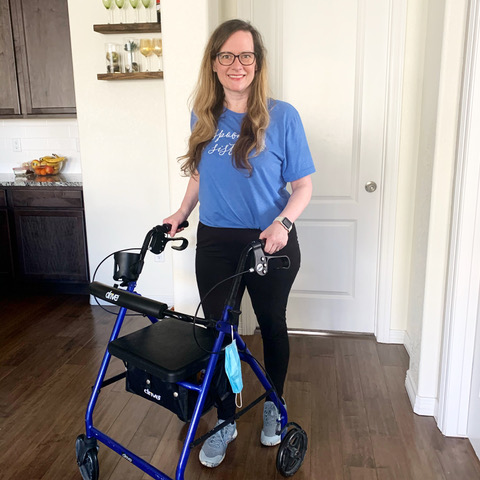By Codi Darnell
March 30, 2021
The first wheelchair I sat in was bright yellow, covered in duct tape and, judging by its size, meant for a large man. As it turns out, most wheelchairs stocked inside a hospital storage room aren’t waiting for someone 5’2” tall. My feet hung down but didn’t make contact with the footrest, and the entire thing was heavy making it difficult for my newly injured body to propel. All this particular wheelchair managed to do was exacerbate my preconceived notions of mobility devices: they are big and ugly, and if you need to use one, well, that’s really sad. It certainly wasn’t the best introduction to the world of mobility aids.
Since then, my wheelchair has become my lifeline and an extension of my body, and those preconceived ideas have all changed. However, the idea that a mobility aid is a good thing is not a widely held opinion. Stigma states that they are only for the elderly or the very sick and that every person using either a wheelchair, crutch, scooter, cane, or other mobility device must be continually sad and embarrassed by its presence in their life. What needs to be understood is that a walker, wheelchair, and every other mobility aid is a solution, not a problem.
 Tara Merrell, the woman behind @stares_and_steps, is a wife and mom from Colorado. Since being diagnosed with multiple sclerosis, she has accumulated quite the collection of mobility aids to assist her in navigating the world. Tara says, “If someone had told me 10 years ago that I would be using a rollator full-time, I would have bawled like a baby, and I might not have been able to stop. Today, I am grateful – grateful that I still have independence, grateful that I can still walk … somewhat.”
Tara Merrell, the woman behind @stares_and_steps, is a wife and mom from Colorado. Since being diagnosed with multiple sclerosis, she has accumulated quite the collection of mobility aids to assist her in navigating the world. Tara says, “If someone had told me 10 years ago that I would be using a rollator full-time, I would have bawled like a baby, and I might not have been able to stop. Today, I am grateful – grateful that I still have independence, grateful that I can still walk … somewhat.”
Tara’s sentiments are mirrored by mobility aid users everywhere. Our devices enable our freedom – they give us the power to move about the world in a way our bodies don’t. But the stigma remains and people without direct exposure to disabled living have a limited view of how man-made equipment benefits those of us whose bodies don’t operate in conventional ways. So how do we create widespread understanding? It’s about visibility.
When I say ‘visibility’ I don’t just mean being noticed because, trust me, people notice. The curious glances often cast in my direction are not always subtle. What I do mean is visibility on a larger scale so that the use of mobility aids becomes integrated into everyone’s range-of-normal. For instance, after actress Selma Blair announced her diagnosis with multiple sclerosis, she began to openly use different mobility devices. She was photographed with canes in a way that was sexy and provocative. She was seen in a wheelchair as well as using a new style of mobility bike that was part of a featured story in People magazine about her. Suddenly millions of people saw someone they were familiar with showing how equipment that often provokes pity was a benefit to her existence. But Selma Blair is just one person, and while it shone a momentary spotlight on the benefits of mobility aids, the positive attention soon faded into the background.
We know that media has the power to help shape our views of the world. And right now, it is not doing enough. More authentic characters with disabilities need to be written about or featured and the talents of people with disabilities need to be utilized more often. Both the roles and the people are out there, but are scattered meagerly throughout film, television and advertising. There is mounting pressure for change and we’re seeing a very slow shift towards a more inclusive industry, but it will take a lot more action to make a real impact.
It’s true, however, that most of us don’t control the media. Even so, there is so much that can be done at a more intimate level. Anyone can take to social media and follow accounts of people with disabilities – if they say something that resonates with you, share it. Companies can expand their hiring practices and individuals can check their biases. Whether it’s through media or everyday living, the more we see the positive use of mobility devices, the less inclined we will be to think of them in a negative light.
That first yellow wheelchair sent me into a tailspin of worry and perpetuated all the negative beliefs I held in my mind about mobility aids. But everything changed by getting into a wheelchair that fit me properly and gave me back my autonomy in the world. My injury inhibits me, but my wheelchair enables me. So many people, just like me, choose their mobility aid every day without hesitation. It is their freedom; it is the solution.
